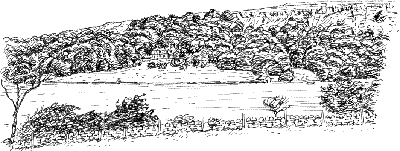 |
Drawn from NatureWednesday, 18th September 2002, West Yorkshire |
![]()
![]()
![]()
![]() Rocks |
History |
Workshop |
Links |
Home Page
Rocks |
History |
Workshop |
Links |
Home Page
![]()

This view of Malham Tarn and Tarn House is for my Malham Magic booklet which has been simmering away in the background for three years.
As I've mentioned before, I'm keen keen to do most of my drawings from nature in the future. As Malham Tarn is only an hour or two's drive from here it's a shame I can't be there drawing this from life today but I took photographs on a day trip there in July, so I might as well use them.
Morrison's 'Mountain Home'
Tarn House was the home of Victorian millionaire Walter Morrison (1836-19). The house replaced the hunting lodge of Lord Ribblesdale. He described it as his ‘mountain home’. His family made a fortune in speculations ranging from Argentinian Railways to cornering the market in black crêpe.Charles Darwin, John Stuart Mill, John Ruskin and Judge Hughes, author of Tom Brown’s Schooldays, visited him there.
Morrison appears as a red-faced squire, John Hartover, in Charles Kingsley's The Water Babies, which was inspired by a visit to Malhamdale. Kingsley (1819-75) described the scenery as ‘a constant joy’ and trout fishing on the Tarn as ‘the best in the whole earth.’
Anyway, enough of that; for more you'll have to wait for my booklet, Malham Magic, which comes out later this year.
Wainwright on Drawing
As an illustrator a regular part of my work has been 'working from photographic reference' but after 25 years in the business I feel that I've earned the right to a change and, as I say, I'll try to plan my work so that drawing from life becomes the norm.When I'm doing a drawing like the one above in which I'm trying to depict the topography as clearly as possible I find myself thinking of A. Wainwright, author of the Lakeland guides, who invariably used a camera to record a scene, working it up in pen and ink later. Discussing his method drawing in Fellwanderer (1966) he revealed;
' . . . the way I did it was cheating. Not for me the patient wait on a fellside boulder for the right conditions, the day-long vigil on the same tuft of grass while the details were faithfully transferred from sight to paper . . . life was too short, too rushed . . .'
For me there's a world, a world of meaning, in a tuft of grass and it's a favourite subject for me. To draw it is to tune in to the mysteries of life. To step out of that rush of times for a few precious moments. But I admire Wainwright's work and, as an example, I've reproduced his drawing of the Tarn from his Pennine Way Companion (below).

Our styles look very similar as reproduced at this resolution but, if you could see the originals, Wainwright has the surer hand. In some of his drawings he approaches the relentless, almost mechanical, hatching you'd find in nineteenth century engraving while elsewhere there's the relaxed, confident graphic look, full of humanity and craftsmanship, of those great countryside illustrators who were flourishing in the post war years - Charles Tunicliffe (1901-1979), Rowland Hilder and, perhaps my all time favourite illustrator, Ernest Shepherd (1879-1976), who spanned both the Victorian and 20th century tradition.
My own illustrations are more of our times. The nineteenth century confidence has gone for good as has the post war optomism. Anyone like myself who uses their eyes to look at the land and ponders on what's going on can't help producing work which reflects the change in our world view. I'd characterise mine as to some degree troubled, restless, questioning - with a wayward nervous quality in the line.
An uneasy feeling of 'Look away and it will be gone.'
![]()
Richard Bell,
wildlife illustrator
E-mail; 'richard@willowisland.co.uk'
![]() Next page |
Previous page |
This day last year |
This month |
Nature Diary |
Home Page
Next page |
Previous page |
This day last year |
This month |
Nature Diary |
Home Page
![]()